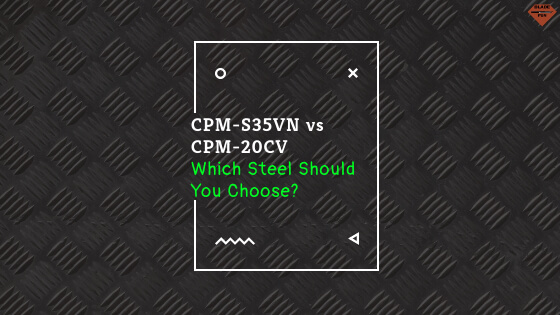S35VN (the full name of which is CPM-S35VN) and 20CV (also called CPM-20CV) are both on the high-end of the spectrum of knife steels. They’re both great options, but what exactly are the differences?
Here’s the short version:
S35VN and 20CV are both great steels, but 20CV is generally better because of its increased edge retention. As a tradeoff, 20CV is also a bit harder to sharpen. S35VN is slightly tougher and easier to sharpen, but its edge retention isn’t as good. 20CV is considered the premium of the two.
Of course, there’s more to it than that–as there is with just about everything. So, let’s dive a bit deeper, shall we?
The Major Differences
The major differences between S35VN and 20CV are edge retention, toughness, and how easy it is to sharpen.
20CV will hold a better edge longer than S35VN, but will be harder to sharpen. It’s a tradeoff: You don’t have to sharpen it as often, but when you do, it’ll be fairly tough. S35VN is the opposite: It will be easier to sharpen, but won’t hold an edge as long.
Toughness is another factor. S35VN is a tougher knife steel than 20CV. So, between the two, S35VN will take more punishment than 20CV. 20CV will be more prone to chipping than S35VN.
There’s also the minor difference of corrosion resistance: 20CV is more corrosion resistant than S35VN, though you likely won’t notice too much of a difference.
Price is also a factor. Because 20CV is technically considered a “super steel,” it’s more expensive. So, in terms of price, S35VN wins out.
Of course, it’s important to note that comparing differences between steel in a vacuum generally doesn’t equate to reality. There are a bunch of other factors that can lead to how well a steel performs and holds up, such as maintenance, heat treat, edge geometry, etc.
Generally, if you get your knife from a reputable knife maker, you’re unlikely to run into these problems.
S35VN
CPM-S35VN is made by Crucible Industries and their CPM (Crucible Particle Metallurgy) process. The CPM process basically makes blades more consistent. It results in finer carbides throughout the blade, which means more consistent (and consistently tough) performance from the steel.
S35VN is actually one of the few steels that were made specifically for the knife industry. Because of that (and it’s properties), it’s a fairly popular steel. It’s also pretty budget friendly–at least, compared to 20CV.
Chemically, S35VN has about 1.4% carbon, 14% chromium, 3% vanadium, 2% molybdenum, and 0.5% niobium. Compared to something like S30V, it’s the slightly tougher older brother.
Each of these elements do different things. The carbon helps with wear resistance and strength–though high amounts of it can actually weaken a blade’s strength. Chromium mainly helps with corrosion resistance. Molybdenum increases hardenability, which basically means that the blade hardens more consistently and is thus more consistently tough.
Vanadium and niobium both help to improve wear resistance and strength, with niobium helping just a bit more than vanadium. Niobium carbides (carbides are basically steel particles) are finer than vanadium, which helps to increase consistency across the blade and means that it can get a finer edge.
S35VN is a really well-balanced steel. It’s like the jack of all trades for knife steels. If you need a well-balanced knife, go with S35VN.
20CV
CPM-20CV is also made by Crucible Industries and their CPM process. It’s a popular steel, too–though for different reasons: It’s considered a “super steel.” Of course, because of that label, it’s quite a bit more expensive than S35VN.
20CV is often compared to other super steels like Bohler M390 (often considered the best all-around knife steel) and CTS-204P.
Chemically, 20CV is made up of 1.9% carbon, 20% chromium, 4% vanadium, 1% molybdenum, and 0.6% tungsten. Tungsten helps to improve the wear resistance and durability of the edge–essentially making the edge last longer. The other elements we looked at earlier with S35VN.
All of that means that 20CV is slightly less tough than S35VN but will hold an edge longer.
Basically…
If you need a knife that’s well-rounded, tough, and easy to sharpen, go with S35VN. If you need a “super steel” with an edge that will last crazily long, go with 20CV. Just beware: 20CV is more expensive than S35VN–sometimes by quite a bit.
If you’re interested in reading more on knife steels and seeing other knife steel comparisons, we’ve got a bunch of articles here that you’ll enjoy.

